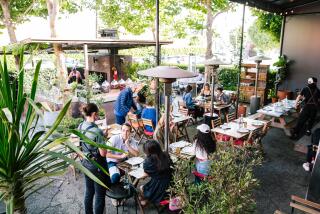Kitchen’s newer shade of cool
MOST of Mark Schomisch’s glass-walled house is so flooded with light that wearing sunglasses inside is almost necessary. Step into his kitchen, however, and night-vision goggles might be the eyewear of choice. It’s dark with slick, black-tiled walls, black marble countertops, oak cabinets stained deep graphite and dusky lights.
“I wanted the kitchen to be an oasis from the brightness,” says the interior designer who remodeled his 1970s French-style house in the Hollywood Hills into a skylight-laden contemporary with views from the Sunset Strip to the ocean. Since he wanted to tear out convention along with the home’s faux mansard roof, he thought, why not tuck the kitchen next to a shaded side yard and make it as dim as a movie theater? “You could show a film in here,” he adds.
There’s a lot more drama in kitchens these days as they continue to take center stage in the home. Some don’t even look much like kitchens. Sinks and cooktops are concealed beneath sliding steel. Trash compactors and other practical-but-not-pretty elements are hidden in niches behind floor-to-ceiling paneled doors. “Sub rooms,” separate small areas off the kitchen, hold walk-in refrigerators; “dirty rooms” keep oil-splattering tasks contained and out of sight. Make a mess, close the doors, and the showcase kitchen remains uncluttered and tidy.
Kitchens are getting bigger and are being used more often as the place to entertain, says Ed Pell, manager of market research for the National Kitchen & Bath Assn., who said consumers spent $127 billion in 2006 on kitchen remodels . “Cooking has become as much a hobby as a necessity,” he says. “A lot of people now do gourmet cooking, or think they do, and they want to show off.”
And if one kitchen doesn’t seem to be enough, are seven too many?
Newport Beach designer Laurie Haefele installed two full-size kitchens and five kitchenettes with a sink, fridge and microwave throughout her client’s Bel-Air estate. There’s a cozy family-kitchen for the owner and her young daughter to make cookies right next to a souped-up kitchen with restaurant-size appliances for the live-in chef. But when guests are invited, Haefele says, everyone eventually winds up in the family kitchen.
Status kitchens, no longer just a place to rattle pots and pans, sport nontraditional colors on walls, doors, cabinetry and countertops. A steel island with glossy electric-blue pearwood panels anchors a new kitchen designed by Geoffrey Frost of Downsview Kitchen Studio of Los Angeles. Frost considers backsplashes another place to add bold colors. He used bright red quartz in an Encino home and tiny mosaic tiles in gray, blue, mauve and pearly tones in a Beverly Hills kitchen where the residents display their folk art collection.
Sleek, ebony-stained, lacquered or laminated surfaces have been popular in lofts for a few years, but now tract houses are embracing this contemporary furniture look. Peek into a kitchen these days and you may wonder: Is that a polished black-and-steel credenza in the middle of the room or a kitchen island with a discrete cooktop?
When Schomisch bought his Hollywood Hills house in 2005, it had a French bistro-type kitchen with hand-painted ceramic tiles and a brick fireplace. That’s all gone, and now the centerpiece is an island with a 6-inch-thick, seamless slab of St. Laurent marble.
Schomisch first saw midnight-colored marble like it in a New York hotel. He bought enough -- at $75 a square foot -- to crown the island and countertops, and found less expensive look-alike tiles to cover the walls.
The telltale signs of a kitchen are hard to find here. Tall doors hide a second sink and bar glasses. A glass-front Viking refrigerator, triple-temperature Viking wine cooler and Miele double oven and warming drawer are lined up on both sides of the entrance so they aren’t noticeable right away.
Cabinets are underneath the countertops, not above them. “It’s frighteningly functional,” he says. “There is tons of storage, just no cabinets where you would expect them to be at eye level.”
When he’s entertaining, he says the mood shifts in a few steps, from a sunning-around-the-pool attitude outside to mellow romance inside the kitchen. “When I’m in here, I almost expect to see someone playing a piano in the corner,” Schomisch says. A center soffit with a frosted-panel skylight and dimming bulbs provides soft illumination.
Museum-quality spotlights beam onto a graceful metal sculpture of a woman standing on an otherwise vacant counter, something else you don’t expect to see in a kitchen.
“The color of the kitchen sets the stage for elegance, whether you’re having a cocktail or eating your cereal,” Schomisch says. “There’s something warm about the dark.”
*
(BEGIN TEXT OF INFOBOX)
Drama from top down
After designing a Hancock Park kitchen for a successful cookbook author and TV personality, Christopher Grubb of Arch-Interiors Design Group Inc. in Beverly Hills and Orlando, Fla., realized that many home cooks are performers at heart. Here are his tips to make your kitchen a cooking stage:
Work space: A well-defined or elevated peninsula around the cooktop and prep area allows the cook to work without interference while still facing guests. Place barstools around the island only where you want people to gather.
Island vents: Don’t block the view of the cook with a bulky ventilator hood dangling from the ceiling. Gaggenau has a sleek, low vent that sits on the island. www.gaggenau-usa.com; (877) 442-4436.
Lights: For efficient illumination, install dimmable, fluorescent lights above or below upper cabinets. Inexpensive rope lights or Xenon low-voltage systems on top of upper cabinets emit an inviting candlelight glow. Available at F.I.R.E./L.T.D. in Los Angeles. www.fireltd.com; (323) 782-9110.
Motorized drapes: Close the curtain on the kitchen from the family room with the flip of a switch, available through design professionals from Fine Draperies in Van Nuys. www.finedrapes.com (818) 989-5567.
-- Janet Eastman


